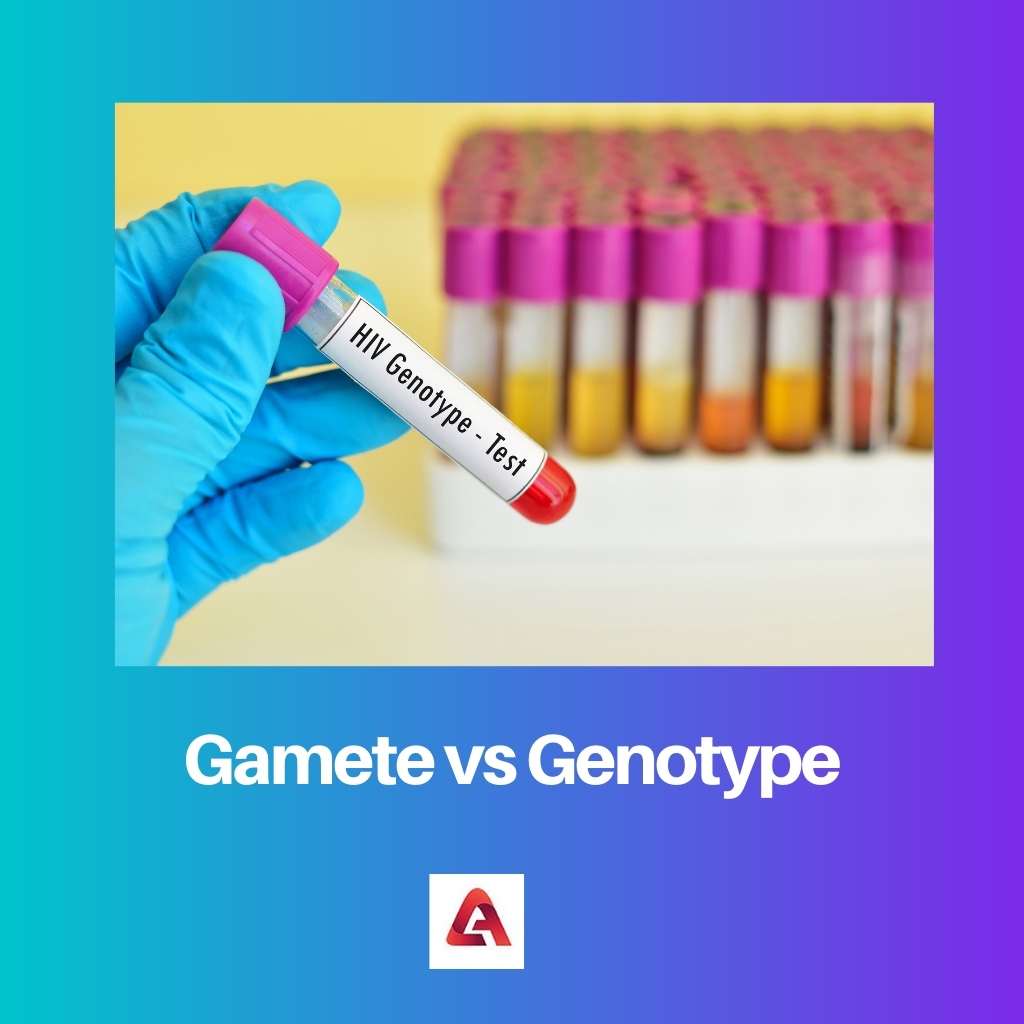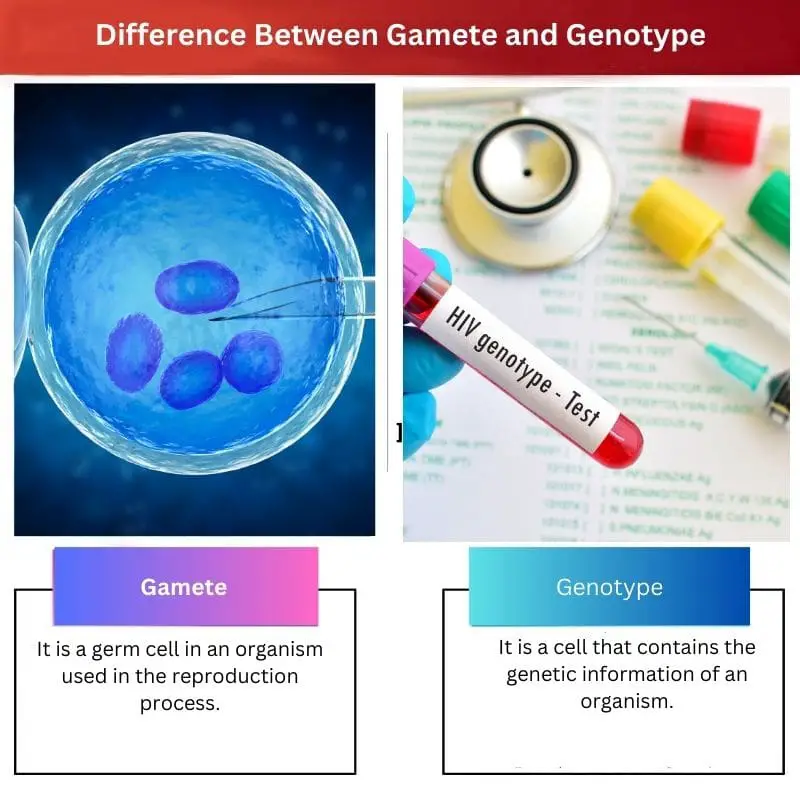An organism has various cell divisions that are passed to the next generation through the reproduction process. Animals, plants, and humans are living organisms that reproduce.
Gametes and genotype are the biological terms used to refer to the different cell divisions and genes. Gametes are reproductive cells, and genotype is the genes of an individual.
Key Takeaways
- Gametes are reproductive cells containing half the genetic material of an organism, while genotypes represent the specific genetic makeup of an individual.
- Gametes participate in sexual reproduction, whereas genotypes result from the combination of parental gametes.
- Gametes exist in two types (sperm and egg), while genotypes contain various combinations of alleles.
Gamete vs Genotype
Gametes are specialized cells involved in sexual reproduction, produced in specialized structures such as pollen grains and ovules. Genotype is the genetic makeup of an individual, determined by the combination of alleles, which can produce different variations of a trait.

A gamete is a haploid cell that contains half of the total chromosomes that are used in the reproduction process to transfer genetic information to offspring.
Gametes cells are present in males as sperms and as eggs in females. Gametes cells work in the fertilization process to create a zygote with a complete set of chromosomes.
On the other hand, the genotype is a structure of the organisms that contain inheritance information in an individual organism. Genetic information is used in forming the shape, colour, and height of the individual.
It is also used in controlling the internal functionalities. It is a blueprint of genes in a body that is analyzed using genetic test methods like DNA.
Comparison Table
| Parameters of Comparison | Gamete | Genotype |
|---|---|---|
| Definition | It is a germ cell in an organism used in the reproduction process. | It is a cell that contains the genetic information of an organism. |
| First Coined by | Gregor Mendel, an Austrian biologist | Wilhelm Johannsen, a Danish botanist |
| Chromosomes | It consists of half of the total chromosomes | It consists of full chromosomes |
| Purpose | Its role is to create a zygote through the fertilization process. | Its role is to transfer genetic information to offspring. |
| Example | Sperm cell and ova | Eye colour, shape, height, and other characteristics of an individual |
What is Gamete?
Gametes are the reproductive cells that transfer genetic information to the next generation of organisms. Sperms in men and an ovum or egg in females are gametes.
Egg cells are larger than sperm cells and have different volumes. Its main job is to fertilize in the reproduction process, where the sperm cells unite with egg cells to form a zygote.
Gametes are germs cells that are produced in gonads. Spermatogenesis is a male gonad and oogenesis is a female gonad. The process of mutation is gametogenesis.
During meiosis, gametes are produced. Isogamy is a reproduction type in which similar gametes in terms of shape and size unite. Anisogamy is a reproduction type in which different sizes and shapes of gametes unite.
Each gamete contains only one factor of genes from their parents. During fertilization, the gametes cells have a random number of sperm and egg cells that cause distinction in the offspring.
In the process of fertilization, four gametes groups are formed in which each gamete contains half of the chromosomes that make it haploid.
In the fertilization process, male and female gametes unite and create an embryo that contains full chromosomes.
All the gametes cells from parents combine to form a diploid cell with full chromosomes, which creates a zygote, and the embryo is a mature zygote.

What is Genotype?
Genes are the inherited characteristics of a person from his parents. A genotype is a group of genes within a person. Every person, plant, or animal has a unique genotype that becomes his identity.
In an organism, there are different copies of Genes, and each copy is termed as alleles. Locus is the position of the alleles in the organisms.
Humans have two alleles as they are diploid organisms that carry genes from father and mother. Each allele represents a specific genotype.
If the person possesses the same alleles, then the genotype of that individual is referred to as homozygous. If the two alleles are different, then it is called a heterozygous genotype.
Genotype is a blueprint of the inheritable information of an organism which is used to maintain the living creatures. The genetic information is passed to future generations during cell division.
Genotype information is internal to individuals and controls the internal functionalities like protein and metabolism formation.
It is a code of instruction that is affected by epigenetic factors and environmental factors.
Some of the examples of genotype are the colour of the eye, height, size, complexion of humans. It is also true for animals and birds.
Genotype depends on the gene sequence of an organism. It is inherited and visible as the genetic makeup of an individual.

Main Differences Between Gamete and Genotype
- Gametes are reproductive cells within an organism, whereas genotype is a blueprint of the genetic information of an individual.
- A gamete is a haploid cell, whereas a genotype can be a haploid or diploid cell depending on genes.
- Gametes create a new embryo, and genotypes determine the traits of new organisms.
- Gametes contain half of the chromosomes, while genotype contains combinations of chromosomes.
- Gametes cells determine the gender, while genotype determines the identity of the individual.

- https://www.sciencedirect.com/topics/medicine-and-dentistry/gamete
- https://www.researchgate.net/publication/318917466_Genotype

The detailed breakdown of the similarities and distinctions between gametes and genotypes is insightful and contributes to an enhanced understanding of reproductive biology.
The comprehensive exploration of gametes and genotypes is crucial in grasping the complexities of genetic inheritance. Well-structured post!
Knowledge and information enveloped in this post are presented in a manner which is both educational and deeply engaging.
The article does a magnificent job at breaking down the main differences between gametes and genotypes. It’s well-written and informative.
The detailed comparison table is extremely helpful in understanding the differences between gametes and genotypes.
While the article is detailed, it might be overwhelming for those who lack a scientific background to fully understand the comparisons made.
The post explains precisely and accurately the key differences between gametes and genotypes. It also provides insightful information on each term.
The explanation of how gametes and genotypes influence the formation of an embryo and the genetic makeup of individuals is well-articulated and educational.
The informative nature of the post is certainly enriching. The article serves as a valuable resource for understanding biological concepts.
The distinction between gametes and genotypes is expressed thoroughly and backed by credible references. I appreciate the clarity.